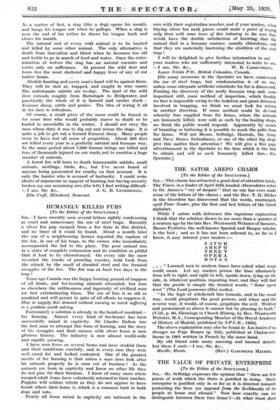HUMANELY KILLED FURS
[To the Editor of the SPEc-rivroa.] SIR,—I have recently seen several letters rightly condemning as cruel and unnecessary the use of steel traps. Recently a silver fox pup escaped from a fox farm in this district, and no trace of it could be found. About a month later the son of a neighbouring farmer reported the capture of the fox, in one of his traps, to the owner, who immediately accompanied the lad to the place. The poor animal was in a state of complete exhaustion and its condition so pitiful that it had to be chloroformed. On every side the snow revealed the tracks of prowling coyotes, held back from the attack by the smell of dreaded steel and the frenzied struggles of the fox. The fox was at least two days in the trap !
Years ago Canada was the happy hunting ground of trappers of all kinds, and fur-bearing animals abounded, but here as elsewhere the ruthlessness and ingenuity of civilized man are fast exterminating them. The use of furs is as old as mankind and will persist in spite of all efforts to suppress it How to supply this demand without causing so much suffering is a problem worth solving.
Fortunately a solution is already in the hands of mankind— fur farming. Almost every kind of fur-bearer has been successfully raised in captivity. Sir Charles Dalton was the first man to attempt this form of farming, and the story of his struggles and final success with silver foxes is now glorious history. The industry is now almost world-wide and rapidly growing.
I have seen foxes on several farms and have studied them and their conditions carefully, and in every case they were well cared for and looked contented. One of the greatest merits of fur farming is that unless a man does look after his animals properly he is soon out of business I As the animals are born in captivity and know no other life they do not pine fOr their freedom. I know of many cases where escaped adult foxes have voluntarily returned to their ranches. Puppies will seldom return as they do not appear to have learnt where their home is, which is a common trait in both dogs and cats.
Nearly all foxes raised in captivity are tattooed in the
ears with their registration number, and if your readers, when buying silver fox neck pieces would make a point of buying only those with some trace of this tattooing in the ears they would have the double satisfaction of knowing that the animal died in a humane manner, usually chloroform, and that they are materially hastening the abolition of the steel trap !
I will be delighted to give further information to ant -your readers who are sufficiently interested to write -to me.
[On many occasions in the Spectator we have condemned the use of steel traps, but condemnation is of no use, unless some adequate artificial substitute for fur is discovered. Pending the discovery of the really humane trap and, more -important still, some method of inspection, which - frankly we fear is impossible owing to the isolation and great distances involved in trapping, we think we must look for reform in another direction. If some method could be devised whereby furs supplied from fur farms, where the animals are humanely killed, were sold as such by the leading shops, we think the public would respond. Apparently by means of branding or tattooing it is possible to mark the pelts from fur farms. Will not Messrs. Selfridge, Harrods, the Army and Navy Stores, Debenhams, or one of the other big shops give this matter their attention? We will give a 'free page advertisement in the Spectator to the firm which is the first to obtain and sell as such humanely killed furs.—ED. Spectator.]








































 Previous page
Previous page